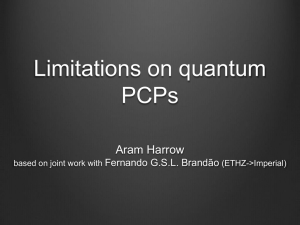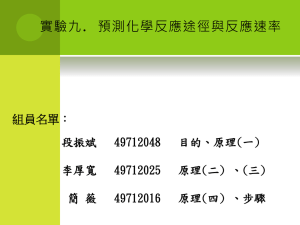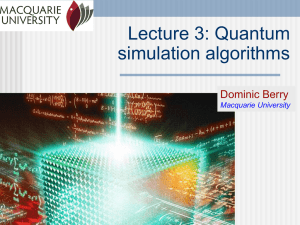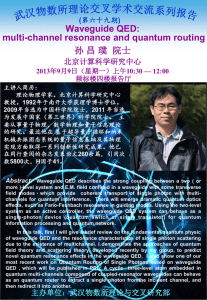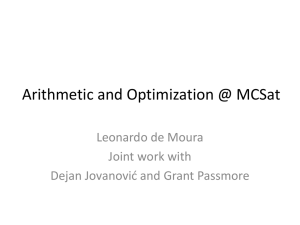pptx - MIT
advertisement
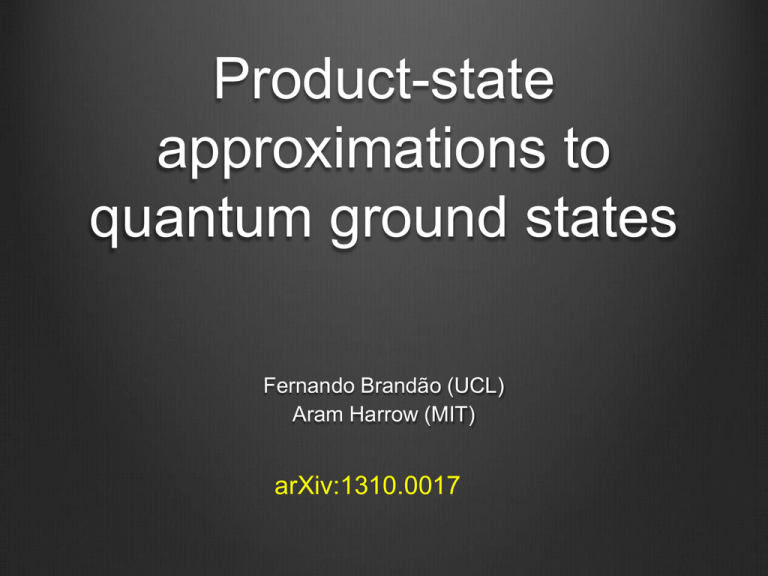
Product-state
approximations to
quantum ground states
Fernando Brandão (UCL)
Aram Harrow (MIT)
arXiv:1310.0017
Constraint Satisfaction Problems
c3
k-CSP:
Variables {x1, …, xn} in
x
Σn
1
Alphabet Σ
Constraints {c1, …, cm}
cj : ∑k {0,1}
x2
x3
x4
x5
x7
c2
UNSAT:=
Includes 3-SAT, max-cut, vertex cover, …
Computing UNSAT is NP-complete
x6
c1
x8
CSPs » eigenvalue problems
Hamiltonian
d = |∑|
local terms
UNSAT = λmin (H)
e.g. Ising model, Potts model, general classical Hamiltonians
Local Hamiltonians, aka
quantum k-CSPs
k-local Hamiltonian:
local terms: each Hi acts nontrivially on ≤ k qudits
and is bounded: ||Hi||≤1
qUNSAT = λmin (H)
optimal assignment = ground state wavefunction
How hard are qCSPs?
Quantum Hamiltonian Complexity addresses this question
The local Hamiltonian problem
Problem
Given a local Hamiltonian H, decide if
λmin(H) ≤α or λmin(H) ≥ α + Δ.
Thm [Kitaev ’99] The local Hamiltonian problem is
QMA-complete for Δ=1/poly(n).
(quantum analogue of the Cook-Levin theorem)
QMA := quantum analogue of NP, i.e. can verify
quantum proof in poly time on quantum computer.
Even simple models are QMA-complete:
Oliveira-Terhal ‘05: qubits on 2-D grid
Aharanov-Gottesman-Irani-Kempe ‘07: qudits in 1-D
Childs-Gosset-Webb: Bose-Hubbard model in 2-D
quantum complexity theory
complexity
classical
quantum
computable in
polynomial time
P
BQP
verifiable in
polynomial time
NP
QMA
q. simulation
P
BQP
factoring
3-SAT
NP
local
Hamiltonian
QMA
Conjectures
Requires exponential
time to solve on
classical computers.
Requires exponential
time to solve even on
quantum computers.
NP vs QMA
Here is the QCD
Can you give me some
Hamiltonian. Can you
description I can use to
decribe the wavefunction
get a 0.1% accurate
of the proton in a way
estimate using fewer
that will let 50
me compute
than 10 steps?
its mass?
Greetings! TheI can, however,
No.proton is the give you many
ground state of
protons, whose
the u, u and dmass you can
quarks.
measure.
Constant accuracy?
3-SAT revisited:
NP-hard to determine if UNSAT=0 or UNSAT ≥ 1/n3
PCP theorem: [Babai-Fortnow-Lund ’90, Arora-Lund-Motwani-Sudan-Szegedy ’98]
NP-hard to determine if UNSAT(C)=0 or UNSAT(C) ≥ 0.1
Equivalent to existence of Probabilistically Checkable Proofs for NP.
Quantum PCP conjecture:
There exists a constant Δ>0 such that it is QMA complete to estimate
λmin of a 2-local Hamiltonian H to accuracy Δ⋅||H||.
-
[Bravyi, DiVincenzo, Terhal, Loss ‘08] Equivalent to conjecture for
O(1)-local Hamiltonians over qudits.
≈ equivalent to estimating the energy at constant temperature.
Contained in QMA. At least NP-hard (by the PCP theorem).
Previous Work and Obstructions
[Aharonov, Arad, Landau, Vazirani ’08]
Quantum version of 1 of 3 parts of Dinur’s proof of the PCP
thm (gap amplification)
But: The other two parts (alphabet and degree reductions)
involve massive copying of information; not clear how to do
it with a highly entangled assignment
[Bravyi, Vyalyi ’03; Arad ’10; Hastings ’12; Freedman, Hastings ’13;
Aharonov, Eldar ’13, …]
No-go (NP witnesses) for large class of commuting
Hamiltonians and almost-commuting Hamiltonians
But: Commuting case might really be easier
result 1: high-degree in NP
Theorem
If H is a 2-local Hamiltonian on a D-regular graph of n
qudits, then there exists a product state
|ψ⟩ = |ψ1⟩ … |ψn⟩ such that
λmin ≤ ⟨ψ|H|ψ⟩ ≤ λmin + O(d2/3 / D1/3)
Corollary
The ground-state energy can be approximated to accuracy
O(d2/3 / D1/3) in NP.
intuition: mean-field theory
∞-D
1-D
2-D
Bethe
lattice
3-D
clustered approximation
Given a Hamiltonian H on a graph G with vertices
partitioned into m-qudit clusters (X1, …, Xn/m), can
approximateλmin to error
with a state that has no
entanglement between clusters.
good approximation if
X
X
X
3
2
1
X
X
1. expansion is o(1)
2. degree is high
3. entanglement satisfies
subvolume law
1. Approximation from low
expansion
Hard instances
must use highly
expanding graphs
X
X
X
3
2
1
X
X
4
5
2. Approximation from high
degree
Unlike classical CSPs:
PCP + parallel repetition imply that 2-CSPs are NP-hard to
approximate to error d®/D¯ for any ®,¯>0.
Parallel repetition maps C C’ such that
1. D’ = Dk
2. Σ’ = Σk
3. UNSAT(C) = 0 UNSAT(C’)=0
UNSAT(C) > 0 UNSAT(C’) > UNSAT(C)
Corollaries:
1. Quantum PCP and parallel repetition not both true.
2. Φ ≤ 1/2 - Ω(1/D) means highly expanding graphs in NP.
3. Approximation from low
entanglement
Subvolume law (S(Xi) << |Xi|) implies NP approximation
1. Previously known only if S(Xi) << 1.
2. Connects entanglement to complexity.
3. For mixed states, can use mutual information instead.
proof sketch
mostly following [Raghavendra-Tan, SODA ‘12]
Chain rule Lemma:
I(X:Y1…Yk) = I(X:Y1) + I(X:Y2|Y1) + … + I(X:Yk|Y1…Yk-1)
I(X:Yt|Y1…Yt-1) ≤ log(d)/k for some t≤k.
Decouple most pairs by conditioning:
Choose i, j1, …, jk at random from {1, …, n}
Then there exists t<k such that
Discarding systems j1,…,jt causes error ≤k/n and leaves a
distribution q for which
Does this work quantumly?
What changes?
😊 Chain rule, Pinsker, etc, still work.
😧 Can’t condition on quantum information.
😥 I(A:B|C)ρ ≈ 0 doesn’t imply ρ is approximately separable
[Ibinson, Linden, Winter ‘08]
Key technique: informationally complete measurement
maps quantum states into probability distributions with
poly(d) distortion.
d-2 || ρ - σ||1 ≤ || M(ρ) – M(σ) ||1 ≤ || ρ - σ ||1
Proof of qPCP no-go
1. Measure εn qudits and condition on outcomes.
Incur error ε.
2. Most pairs of other qudits would have mutual
information
≤ log(d) / εD if measured.
3. Thus their state is within distance d2(log(d) / εD)1/2 of
product.
4. Witness is a global product state. Total error is
ε + d2(log(d) / εD)1/2.
Choose ε to balance these terms.
result 2: “P”TAS
PTAS for Dense k-local Hamiltonians
improves on 1/dk-1 +εapproximation from [Gharibian-Kempe ’11]
PTAS for planar graphs
Builds on [Bansal, Bravyi, Terhal ’07] PTAS
for bounded-degree planar graphs
Algorithms for graphs with low threshold rank
Extends result of [Barak, Raghavendra, Steurer ’11].
run-time for ε-approximation is
exp(log(n) poly(d/ε) ⋅#{eigs of adj. matrix ≥ poly(ε/d)})
The Lasserre SDP hierarchy
for local Hamiltonians
Quantum
Classical
problem
LP hierarchy
2-local Hamiltonian
2-CSP
Optimize over k-body marginals
E[f] for deg(f) ≤ k
⟨ψ|H|ψ⟩ for k-local H
(technically an SDP)
Add global PSD constraint
SDP hierarchy
analysis when
k = poly(d/ε)⋅
rankpoly(ε/d)(G)
for deg(f)≤k/2
⟨ψ|H†H|ψ⟩≥0
for k/2-local H
Barak-Raghavendra-Steurer
1104.4680
similar
E[f2]≥0
Open questions
1. The Quantum PCP conjecture!
Is quantum parallel repetition possible?
Are commuting Hamiltonians easier?
1. Better de Finetti theorems / counterexamples
main result says random subsets of qudits are ≈ separable
Aharonov-Eldar have incomparable qPCP no-go.
2. Unifying various forms of Lasserre SDP hierarchy
(a) approximating separable states via de Finetti (1210.6367)
(b) searching for product states for local Hamiltonians (this talk)
(c) noncommutative positivstellensatz approach to games
3. SDP approximations of lightly entangled time evolutions

